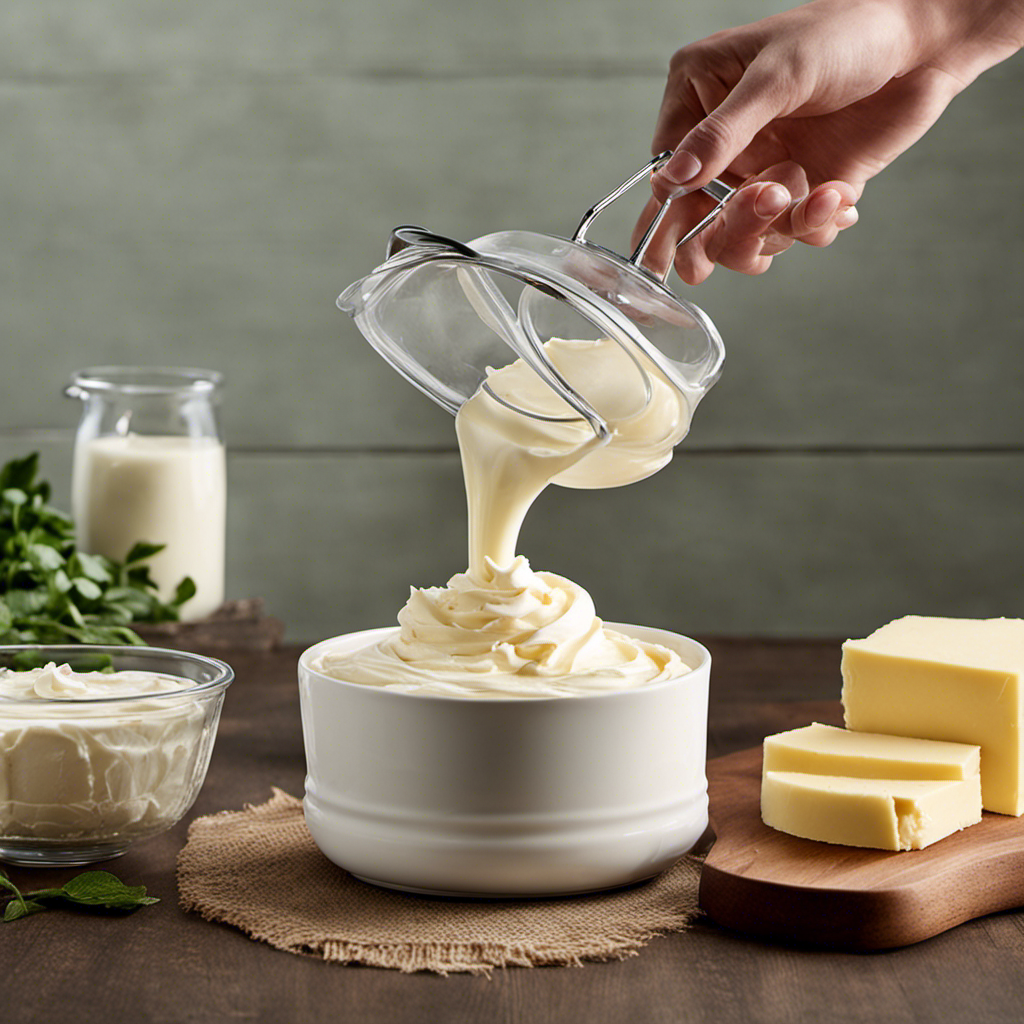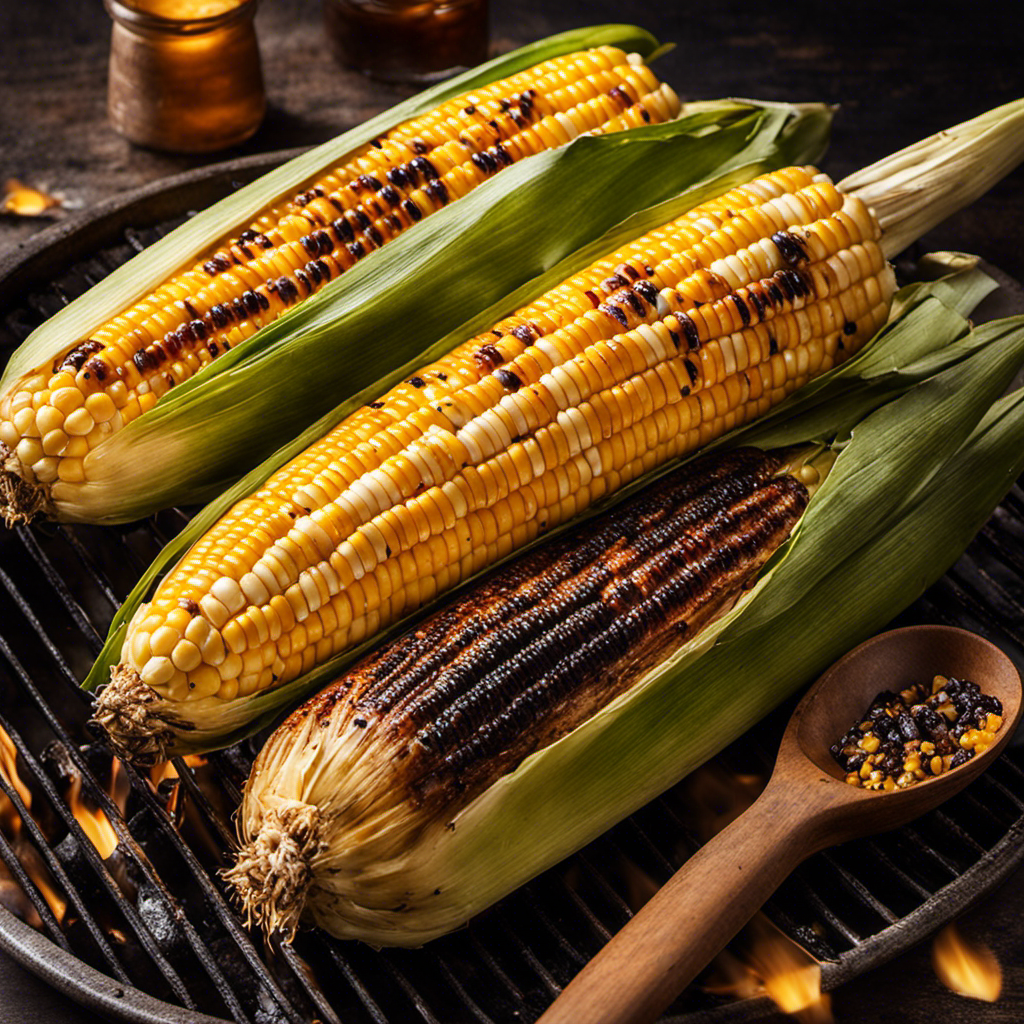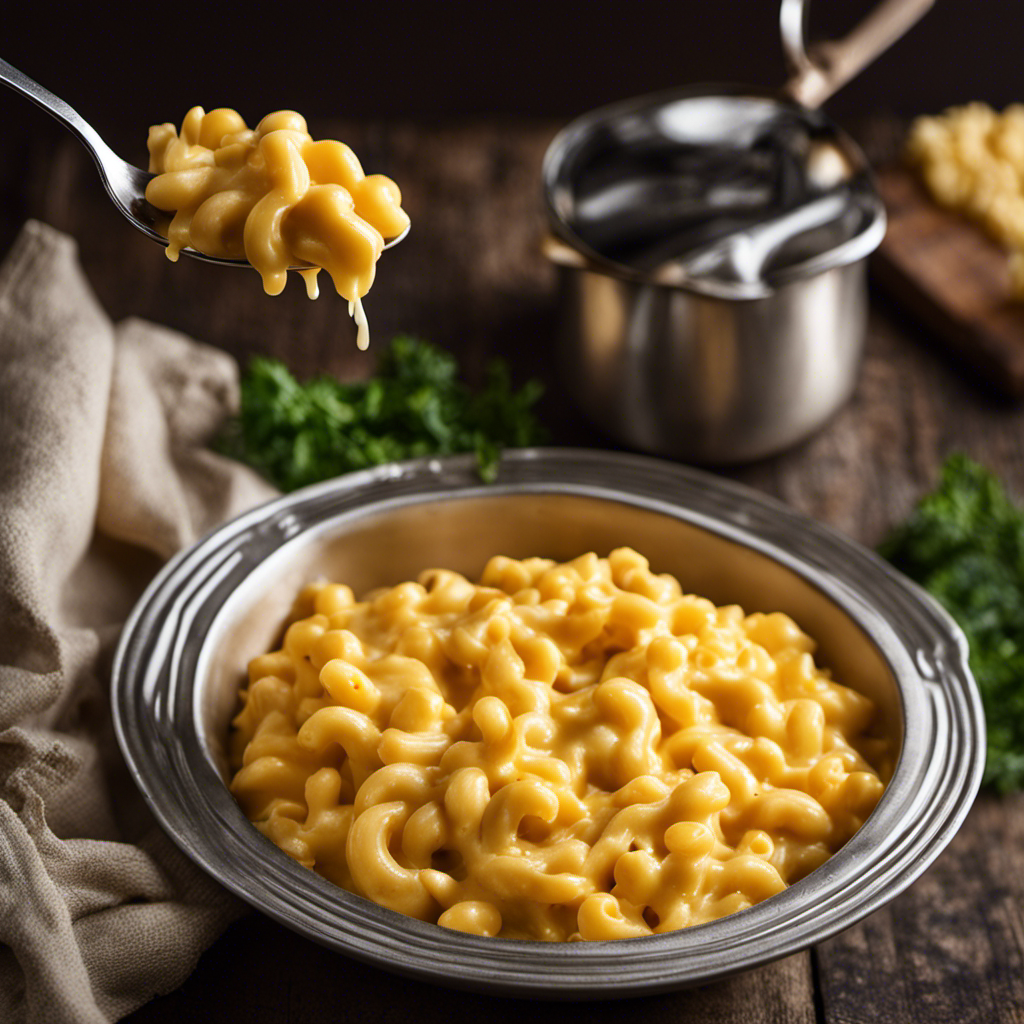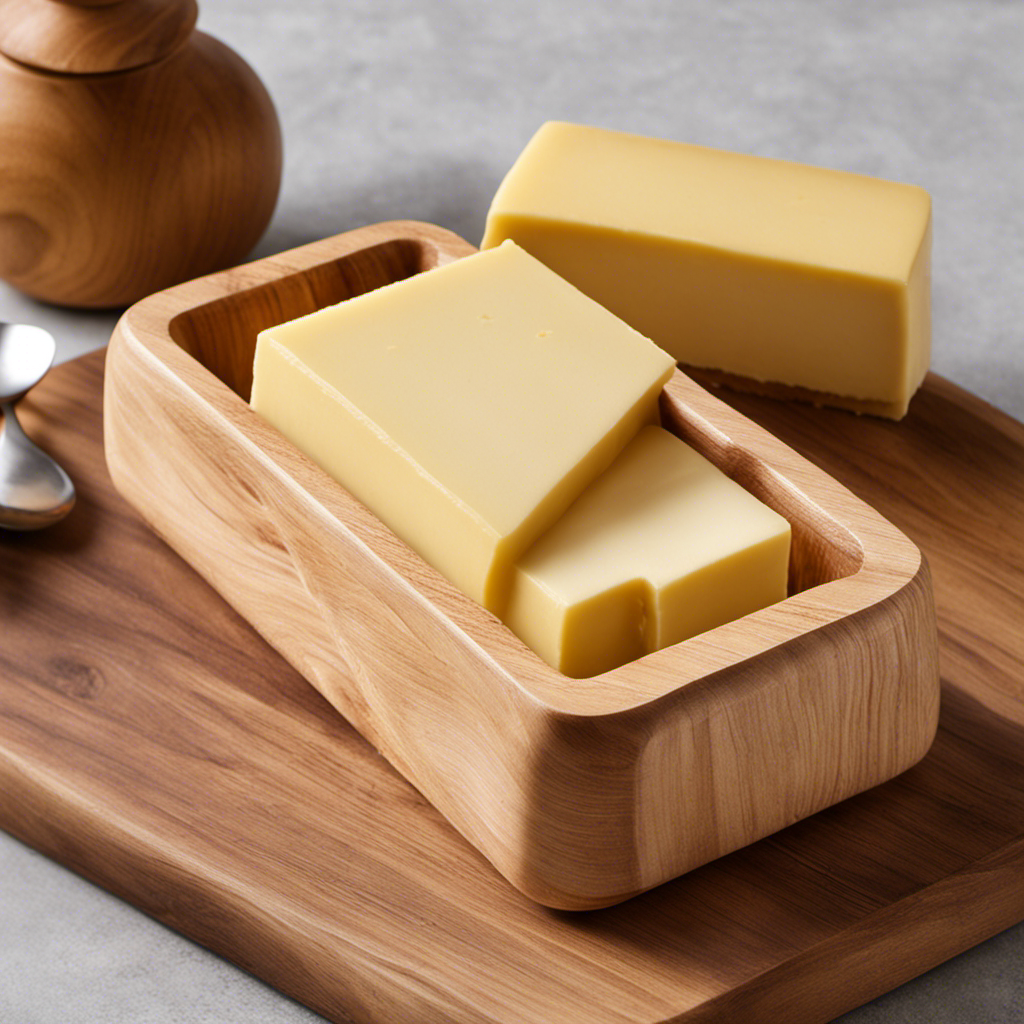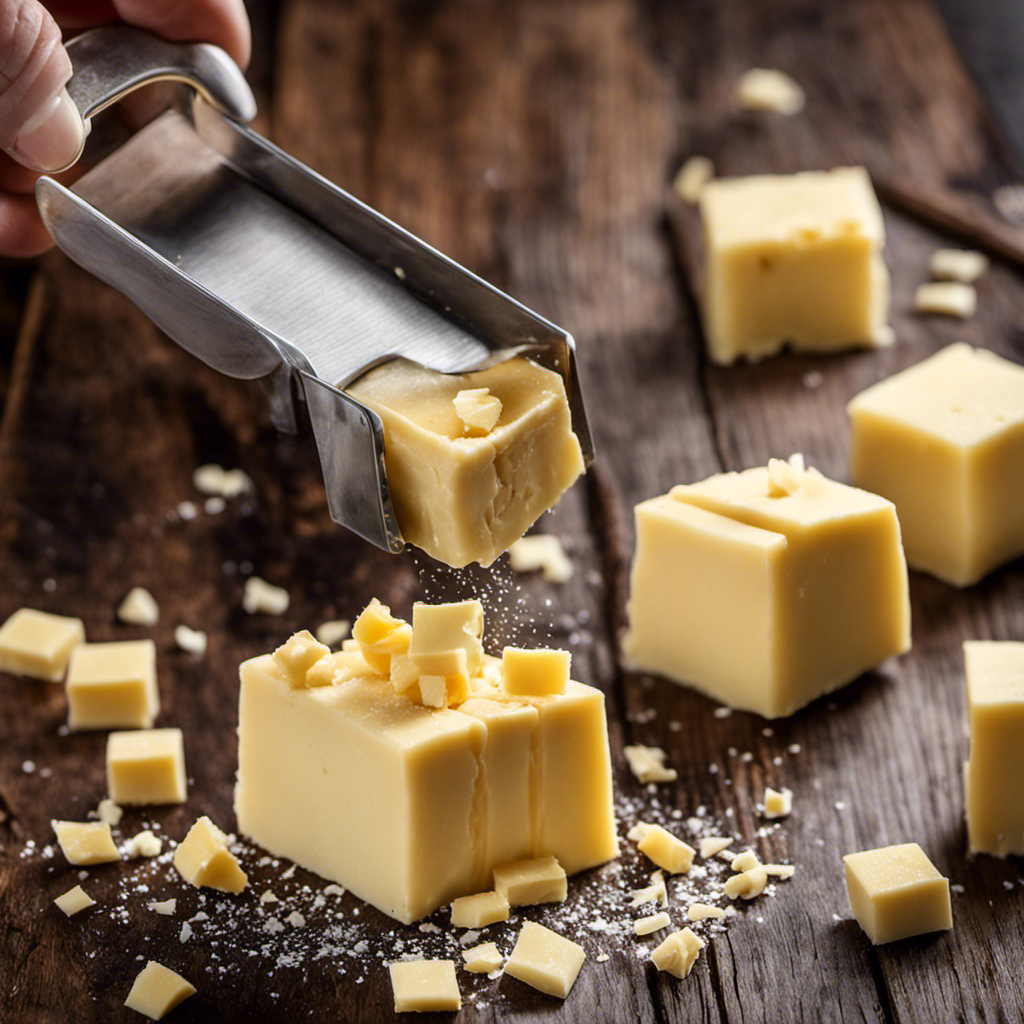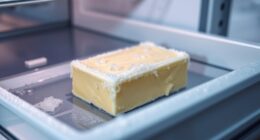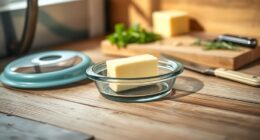I am amazed at how simple it is to prepare smooth, homemade butter using the Pampered Chef Whipped Cream Maker!
In just a few simple steps, you’ll have delicious, fresh butter that will elevate your cooking and baking to a whole new level.
With the right ingredients and this handy kitchen tool, you’ll be able to whip up butter in no time.
Get ready to impress your friends and family with this homemade delight!
Key Takeaways
- Use cream with high fat content for rich and creamy butter.
- Properly assemble and maintain the whipped cream maker for optimal performance.
- Accurately measure the cream and use the optimal mixing technique for light and fluffy whipped cream.
- Drain, wash, and store the butter properly to achieve a smooth texture and maintain freshness.
Choosing the Right Ingredients
To make butter with the Pampered Chef whipped cream maker, you’ll need to choose the right ingredients. The first and most important ingredient is cream. Look for heavy cream or whipping cream with a high fat content, around 35% or more. This will ensure that your butter turns out rich and creamy. If you prefer a lighter butter, you can also use half and half or a combination of milk and cream. Another alternative ingredient is cultured cream, which will give your butter a tangy flavor. Make sure to choose organic or high-quality cream for the best results.
Now that you know about the different cream options, let’s move on to assembling the Pampered Chef whipped cream maker.
Assembling the Pampered Chef Whipped Cream Maker
When it comes to assembling the Pampered Chef Whipped Cream Maker, effective assembly steps are crucial for success.
In this discussion, I will walk you through the key points of assembling this handy kitchen tool, ensuring that you have a smooth and hassle-free experience.
Additionally, I will also address common issues that may arise during assembly and provide troubleshooting tips to help you overcome any obstacles.
Effective Assembly Steps
To effectively assemble the Pampered Chef whipped cream maker, follow these steps:
-
Attach the dispenser head to the canister, making sure it is securely screwed on to prevent leaks.
-
Insert the charger into the charger holder located on the underside of the canister. This provides the necessary pressure to whip the cream.
-
Place the silicone gasket on top of the canister and twist the cap on tightly to seal everything in place.
If you encounter any assembly issues, such as the dispenser head not fitting properly, follow these troubleshooting steps:
-
Check to make sure all parts are clean and free of debris.
-
Ensure that the charger is properly inserted into the holder.
Troubleshooting Common Issues
If the dispenser head doesn’t fit properly, check for any debris or dirt on the parts and make sure the charger is inserted correctly.
Troubleshooting issues with the Pampered Chef whipped cream maker is important to ensure smooth operation and delicious results.
One common problem that may arise is the dispenser head not fitting snugly onto the canister. This could be due to debris or dirt on the parts, preventing a proper seal. In such cases, it’s important to thoroughly clean both the dispenser head and canister before reassembling.
Another common issue is the charger not being inserted correctly. Make sure to follow the instructions carefully and ensure that the charger is properly punctured.
Adding the Cream to the Whipped Cream Maker
When it comes to making whipped cream, there are three key points to consider: proper cream measurement, whipped cream maker assembly, and optimal mixing technique.
First, it is important to measure the cream accurately to ensure the perfect consistency.
Second, assembling the whipped cream maker correctly is crucial for it to function properly.
Finally, using the optimal mixing technique will help achieve light and fluffy whipped cream that is sure to impress.
Let’s dive into each of these points to master the art of homemade whipped cream.
Proper Cream Measurement
Make sure you accurately measure the cream for the best results with your Pampered Chef whipped cream maker. Proper cream measurement is crucial to achieving the perfect consistency and texture. Here are three tips to help you get it right:
-
Use measuring tools: To ensure accurate measurements, use measuring cups or a kitchen scale. This will help you get the right amount of cream every time.
-
Follow the recipe: Pay close attention to the recipe instructions and measure the cream according to the specified amount. This will help you achieve the desired results and prevent any issues with the whipped cream maker.
-
Troubleshooting techniques: If the cream doesn’t whip properly or the consistency is off, try adjusting the amount of cream you’re using. Too much cream can result in a runny texture, while too little cream may not whip at all. Experiment with different measurements until you find the perfect balance.
Whipped Cream Maker Assembly
The assembly of the whipped cream maker is straightforward and can be done quickly. To give you a clear picture, here’s a table that outlines the different parts of the whipped cream maker and their functions:
| Part | Function | Maintenance Tips |
|---|---|---|
| Canister | Holds the cream | Clean after each use, avoid submerging in water |
| Dispensing Valve | Controls cream flow | Regularly check for clogs, clean if necessary |
| Charger Holder | Holds nitrous oxide charger | Replace when damaged or worn out |
| Nozzle | Dispenses whipped cream | Clean thoroughly, remove any clogs |
| Rubber Gasket | Seals the canister | Check for wear and tear, replace if needed |
Maintenance is important to ensure optimal performance and longevity of your whipped cream maker. Common issues you may encounter include clogs in the dispensing valve or nozzle, leaks from a worn-out rubber gasket, or difficulty in dispensing cream. Troubleshooting these issues usually involves cleaning the affected parts or replacing worn-out components.
Now that we have the whipped cream maker assembled and understand how to maintain it, let’s move on to the next section: optimal mixing technique.
Optimal Mixing Technique
To achieve the best results, it’s important to follow the recommended mixing technique for optimal whipped cream. Here are three key steps to ensure your whipped cream turns out light, fluffy, and perfect every time:
-
Start with chilled cream: For the best results, make sure your whipping cream is cold. This will help it whip up faster and hold its shape better.
-
Use the right mixing speed: When using a Pampered Chef Whipped Cream Maker, start on the lowest speed setting and gradually increase it as the cream begins to thicken. This will prevent overmixing and ensure a creamy texture.
-
Watch for butter consistency: Keep a close eye on the cream as you mix it. It should form soft peaks that hold their shape but are not stiff. If you continue to mix beyond this point, you risk turning the cream into butter.
Turning on the Whipped Cream Maker
First, you’ll need to attach the nozzle to the Whipped Cream Maker. Make sure it is securely fastened so that no air escapes during the butter-making process.
Once the nozzle is attached, it’s time to turn on the Whipped Cream Maker. Simply locate the power switch and flip it on. You should hear a soft hum as the machine powers up.
If you encounter any technical difficulties, such as the machine not turning on or making strange noises, try troubleshooting by checking the power source and making sure all connections are secure. If the problem persists, consult the user manual or contact the manufacturer for further assistance.
Once the machine is on, you can adjust the speed settings to your desired level. Start with a low setting and gradually increase the speed as needed.
Beating the Cream to Make Whipped Cream
Once you’ve attached the nozzle and turned on the machine, you can start beating the cream to make delicious whipped cream. It’s important to use heavy cream, as it has a higher fat content that will result in a richer and more stable whipped cream.
Here are three tips to help you achieve the perfect whipped cream:
-
Chill your bowl and whisk attachment in the freezer for about 10 minutes before starting. This will help the cream whip faster and hold its shape better.
-
Start on low speed and gradually increase to medium-high speed. This will prevent splattering and ensure even whipping.
-
Stop beating when soft peaks form. Over-whipping can result in clumpy, grainy whipped cream. It should be light, fluffy, and hold its shape when dolloped onto desserts.
If you’re looking for whipped cream alternatives or want to experiment with different flavors, you can add flavored extracts like vanilla or almond, or even incorporate cocoa powder or fruit purees for a unique twist.
Continuing to Beat the Cream for Butter
As I continue beating the cream for a longer period of time, it will start to separate into butter and buttermilk. This is the next step in the process of making butter with the Pampered Chef Whipped Cream Maker.
The beating techniques are crucial here, as the cream needs to be whipped until it reaches a thick consistency. I like to use a hand mixer for this, as it allows me to control the speed and intensity of the beating.
As the cream is beaten, it will gradually transform into butter and buttermilk. The butter will start to clump together, while the liquid buttermilk will separate. This is when you know you’ve achieved the desired result.
Now, you can experiment with different flavor variations by adding herbs, spices, or even sweeteners to your homemade butter. Get creative and enjoy the process of making your very own flavorful butter.
Draining the Buttermilk From the Butter
To separate the buttermilk from the butter, you’ll need to strain the mixture through a fine-mesh sieve or cheesecloth. This step is essential to achieve the smoothest consistency for your homemade butter.
Here’s how to do it:
-
Prepare your straining equipment: Place a fine-mesh sieve or a double layer of cheesecloth over a bowl or container large enough to hold the strained liquid.
-
Pour the mixture into the strainer: Slowly pour the churned butter and buttermilk mixture into the sieve or cheesecloth. The liquid will pass through, leaving behind the solid butter.
-
Collect the drained buttermilk: Allow the liquid to fully drain into the bowl or container. This buttermilk can be used in various recipes, such as pancakes, biscuits, or even as a marinade for chicken.
Washing and Kneading the Butter
After draining the buttermilk from the butter, the next step is to wash and knead it. This helps remove any remaining buttermilk and enhances the butter’s texture and flavor. To do this, I fill a bowl with ice-cold water and place the butter in it. Using a spatula, I gently press and knead the butter against the sides of the bowl. This washing technique helps remove any residual buttermilk, which can cause the butter to spoil quickly. I repeat this process a few times, changing the water each time, until the water remains clear. Once the butter is thoroughly washed, I transfer it to a clean surface and continue kneading it by hand. This kneading process helps remove any remaining moisture and ensures a smooth and creamy texture.
To give you a visual representation of the process, here’s a table showing the steps involved in washing and kneading the butter:
| Step | Description |
|---|---|
| 1 | Fill a bowl with ice-cold water |
| 2 | Place the butter in the water |
| 3 | Press and knead the butter against the sides of the bowl |
| 4 | Repeat the process, changing the water each time, until it remains clear |
| 5 | Transfer the butter to a clean surface |
| 6 | Continue kneading the butter by hand to remove remaining moisture |
| 7 | Enjoy the smooth and creamy homemade butter! |
Storing and Using Your Homemade Butter
Once the butter is thoroughly washed and kneaded, you can store it in an airtight container in the refrigerator for up to two weeks. Storing homemade butter properly is important to maintain its freshness and flavor. Here are three tips for storing and using your homemade butter:
-
Keep it in an airtight container: To prevent the butter from absorbing odors and flavors from other foods in the fridge, store it in a tightly sealed container. This will also help to maintain its creamy texture.
-
Label and date your container: It’s easy to forget when you made your homemade butter, so make sure to label the container with the date. This way, you’ll know when it’s time to use it or make a fresh batch.
-
Get creative with your butter: Homemade butter is incredibly versatile and can be used in a variety of ways. Spread it on toast, melt it over vegetables, or use it as a base for baking and cooking. The possibilities are endless!
Conclusion
In conclusion, making butter with the Pampered Chef Whipped Cream Maker was a delightful journey.
With just a few simple steps, I transformed ordinary cream into a heavenly spread.
As I watched the cream transform, it was like witnessing a magical dance of flavors.
The smooth texture and rich taste of the homemade butter were like a symphony of indulgence on my taste buds.
Now, I can’t wait to spread this creamy goodness on warm, freshly baked bread and savor the satisfaction of creating something truly butterylicious.
